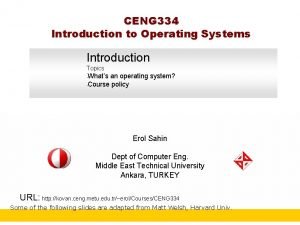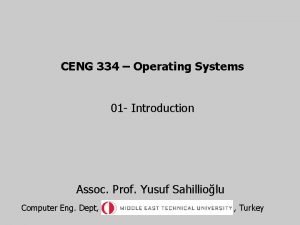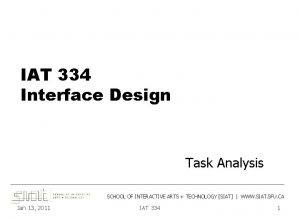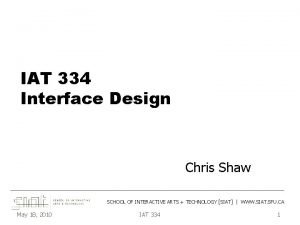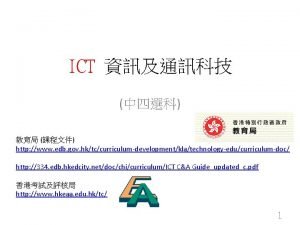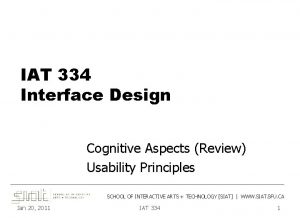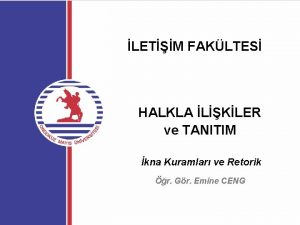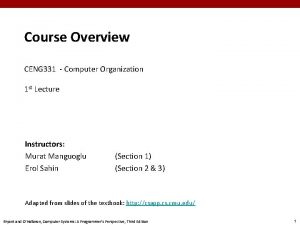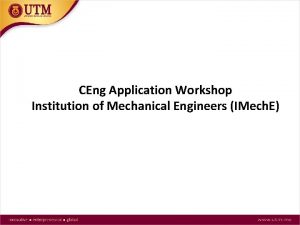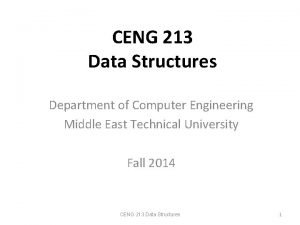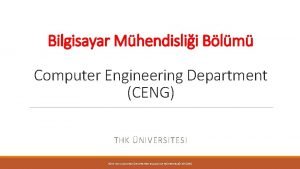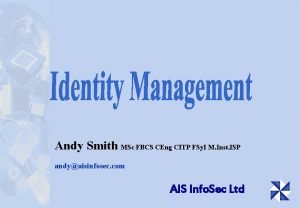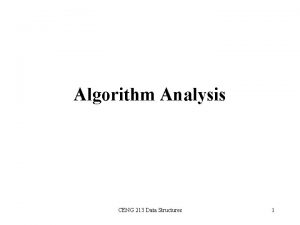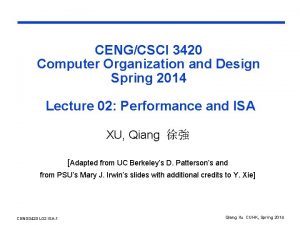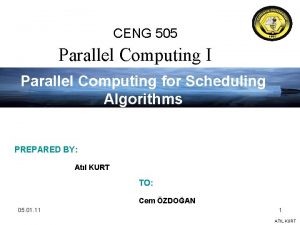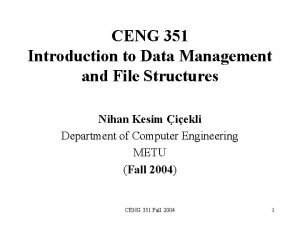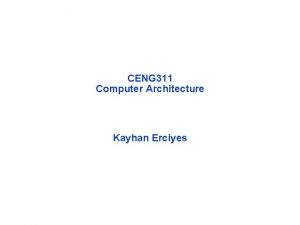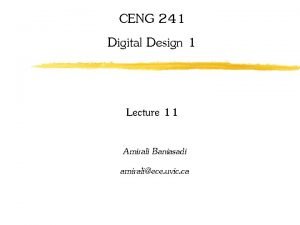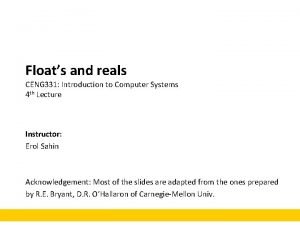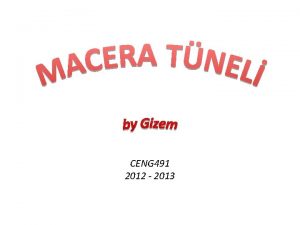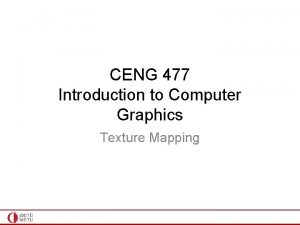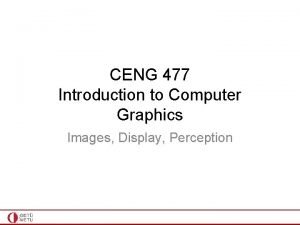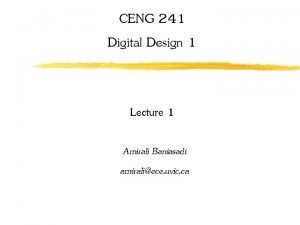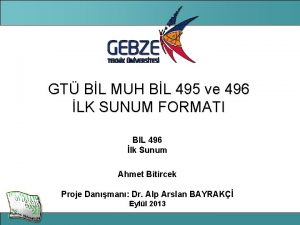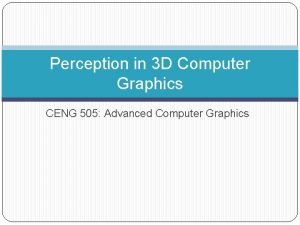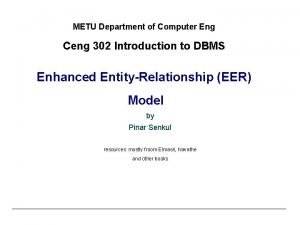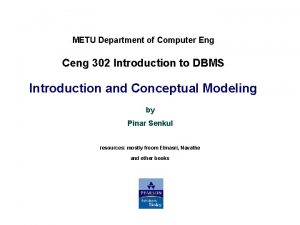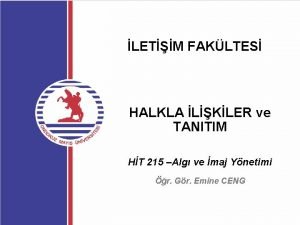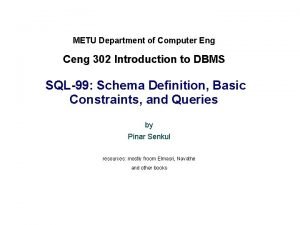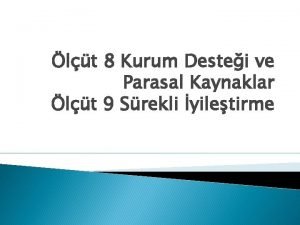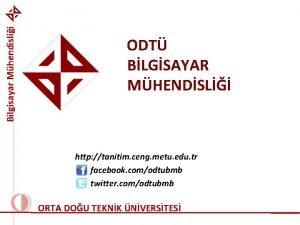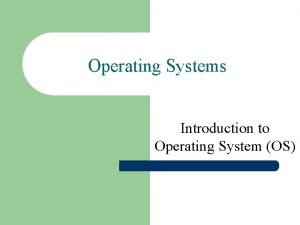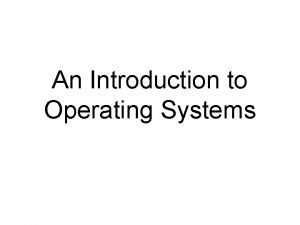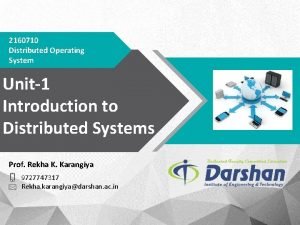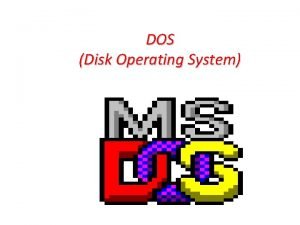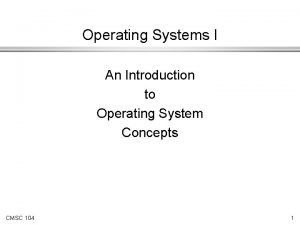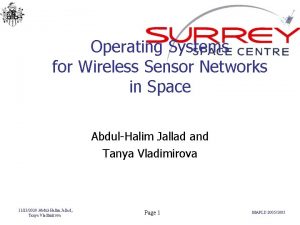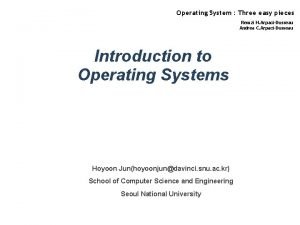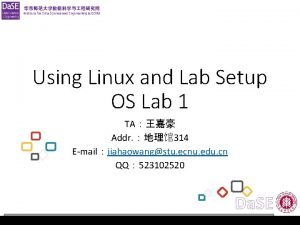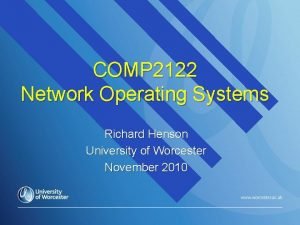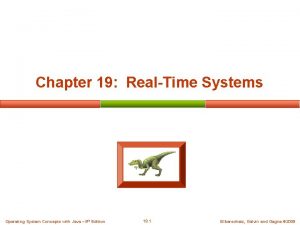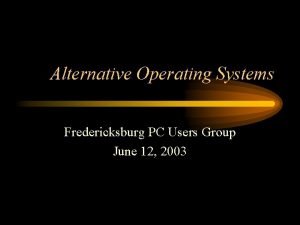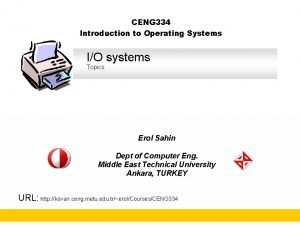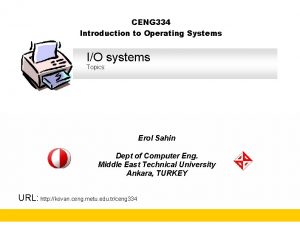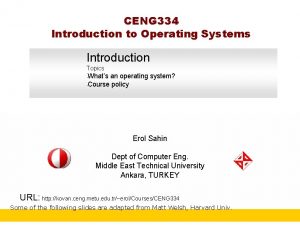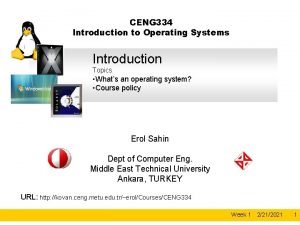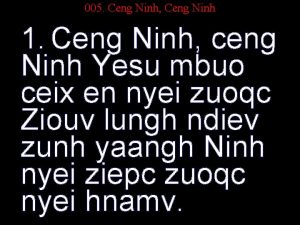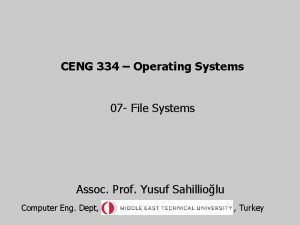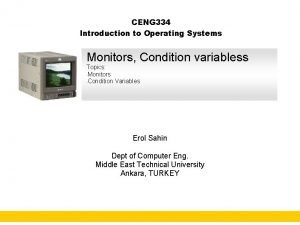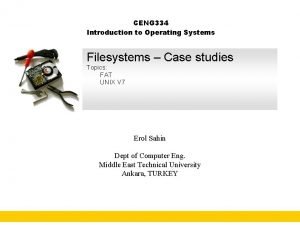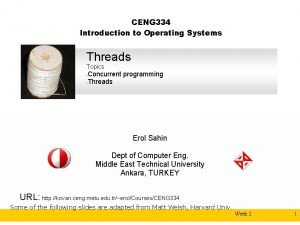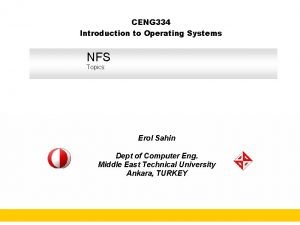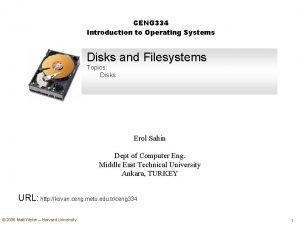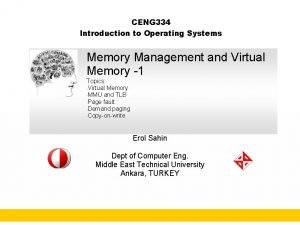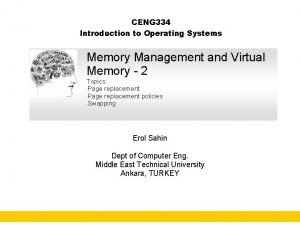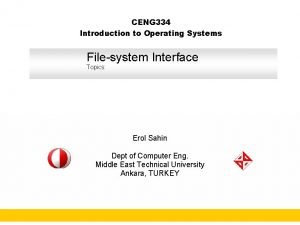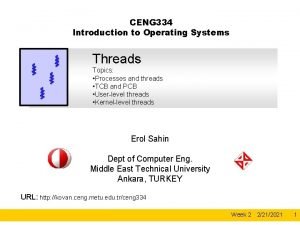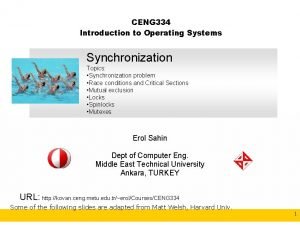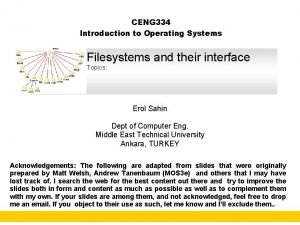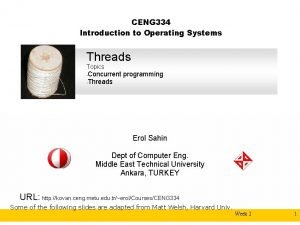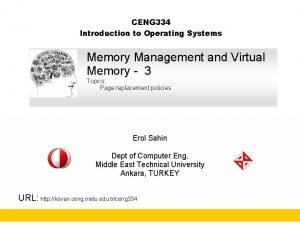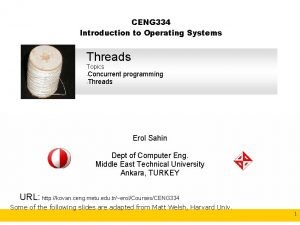CENG 334 Introduction to Operating Systems IO systems

























































- Slides: 57

CENG 334 Introduction to Operating Systems I/O systems Topics: Erol Sahin Dept of Computer Eng. Middle East Technical University Ankara, TURKEY URL: http: //kovan. ceng. metu. edu. tr/~erol/Courses/CENG 334

I/O systems The two main jobs of a computer are I/O and processing. A computer without I/O support is more like a turkey who is claimed to think but not speak. . Hence, I/O is an essential part of an operating system. In many cases, the main job is I/O and the processing is merely incidental. browse a web page or edit a file 2

I/O devices Widely vary in in their types and characteristics, hence their interfacing within the OS. I/O-device technology exhibits two conflicting trends. increasing standardization of software and hardware interfaces. increasingly broad variety of I/O devices. Hardware Ports Buses Device controllers Software Device drivers present a uniform device-access interface to the I/O subsystem, Similar to system calls providing a standard interface between the application and the operating system. 3

Modern I/O Systems Slide from Kubiatowichz 4

I/O Hardware General Categories storage devices (disks, tapes), transmission devices (network cards, modems), human-interface devices (screen, keyboard, mouse), Specialized devices 5

I/O Devices: Hardware interfacing Interfacing medium Wired wireless Interfacing Components Port: one device can be connected (e. g. serial port) Bus: More than one device Device controller 6

Memory-Mapped I/O (1) (a) A single-bus architecture. (b) A dual-bus memory architecture. Tanenbaum, Modern Operating Systems 3 e, (c) 2008 Prentice-Hall, Inc. All rights reserved. 0 -13 -6006639 7

Memory-Mapped I/O (2) How can the processor give commands and data to a controller to accomplish an I/O transfer? controller has one or more registers for data and control signals. processor communicates with the controller by reading and writing bit patterns in these registers How to write and read these registers Specialized I/O instructions Memory-mapped I/O Pros and cons? Hybrid Tanenbaum, Modern Operating Systems 3 e, (c) 2008 Prentice-Hall, Inc. All rights reserved. 0 -13 -6006639 8

Device I/O port locations on PC 9

I/O ports Device controller status Device driver OS An I/O port typically consists of four registers, status register contains bits that can be read by the host. These bits indicate states such as whether the current command has completed, whether a byte is available to be read from the data-in register, and whethere has been a device error. control register can be written by the host to start a command or to change the mode of a device. data-in register is read by the host to get input. data-out register is written by the host to send output. command data-in data-out 10

I/O interfacing in SW: Polling A typical interaction loop 1. The host repeatedly reads the busy bit (in status register) until that bit becomes clear 2. The host sets the write bit in the command register and writes a byte into the data-out register. 3. The host sets the command-ready bit. 4. When the controller notices that the command-ready bit is set, it sets the busy bit. 5. The controller reads the command register and sees the write command. It reads the data-out register to get the byte, and does the I/O to the device. 6. The controller clears the command-ready bit, clears the error bit in the status register to indicate that the device I/O succeeded, and clears the busy bit to indicate that it is finished. status command data-in data-out 11

I/O interfacing in SW: Polling typically requires three CPU-instruction cycles read the status register, logical–and to extract a status bit, and branch if not zero. status command data-in data-out 12

I/O interfacing in SW: Polling A typical interaction loop 1. The host repeatedly reads the busy bit (in status register) until that bit becomes clear 2. The host sets the write bit in the command register and writes a byte into the data-out register. 3. The host sets the command-ready bit. 4. When the controller notices that the command-ready bit is set, it sets the busy bit. 5. The controller reads the command register and sees the write command. It reads the data-out register to get the byte, and does the I/O to the device. 6. The controller clears the command-ready bit, clears the error bit in the status register to indicate that the device I/O succeeded, and clears the busy bit to indicate that it is finished. status command data-in data-out 13

Programmed I/O (1) Steps in printing a string. Tanenbaum, Modern Operating Systems 3 e, (c) 2008 Prentice-Hall, Inc. All rights reserved. 0 -13 -6006639 14

Programmed I/O (2) Writing a string to the printer using programmed I/O. Tanenbaum, Modern Operating Systems 3 e, (c) 2008 Prentice-Hall, Inc. All rights reserved. 0 -13 -6006639 15

Interrupts Revisited How an interrupt happens. The connections between the devices and the interrupt controller actually use interrupt lines on the bus rather than dedicated wires. Tanenbaum, Modern Operating Systems 3 e, (c) 2008 Prentice-Hall, Inc. All rights reserved. 0 -13 -6006639 16

Interrupt servicing Interrupt mechanism needs Address: to select a specific interrupt handling routine Typically an offset in a table called interrupt vector which contains addresses of interrupt handlers 17

I/O interfacing: Interrupts CPU hardware has a wire called the interrupt-request line that the CPU senses after executing every instruction. Upon interrupt, the CPU saves a small amount of state, such as the current value of the instruction pointer, and jumps to the interrupt-handler routine at a fixed address in memory. interrupt handler determines the cause of the interrupt, performs the necessary processing, and executes a return from interrupt instruction to return the CPU to the execution state prior to the interrupt. 18

Interrupt Handlers (1) Save registers not already been saved by interrupt hardware. Set up a context for the interrupt service procedure. Set up a stack for the interrupt service procedure. Acknowledge the interrupt controller. If there is no centralized interrupt controller, reenable interrupts. Copy the registers from where they were saved to the process table. Tanenbaum, Modern Operating Systems 3 e, (c) 2008 Prentice-Hall, Inc. All rights reserved. 0 -13 -6006639 19

Interrupt Handlers (2) Run the interrupt service procedure. Choose which process to run next. Set up the MMU context for the process to run next. Load the new process’ registers, including its PSW. Start running the new process. Tanenbaum, Modern Operating Systems 3 e, (c) 2008 Prentice-Hall, Inc. All rights reserved. 0 -13 -6006639 20

Interrupt-Driven I/O Writing a string to the printer using interrupt-driven I/O. (a) Code executed at the time the print system call is made. (b) Interrupt service procedure for the printer. Tanenbaum, Modern Operating Systems 3 e, (c) 2008 Prentice-Hall, Inc. All rights reserved. 0 -13 -6006639 21

Interrupts (other good uses than I/O) Virtual memory paging A page fault is an exception that raises an interrupt. The interrupt suspends the current process and jumps to the page-fault handler in the kernel. This handler saves the state of the process, moves the process to the wait queue, performs page-cache management, schedules an I/O operation to fetch the page, schedules another process to resume execution, and then returns from the interrupt 22

Interrupts (other good uses than I/O) System Call (low-priority interrupt) checks the arguments given by the application, builds a data structure to convey the arguments to the kernel, and then executes a special instruction called a software interrupt (or a trap). This instruction has an operand that identifies the desired kernel service. When the system call executes the trap instruction, the interrupt hardware saves the state of the user code, switches to supervisor mode, and dispatches to the kernel routine that implements the requested service. 23

Interrupt servicing: Advanced Modern interrupt controllers provide The ability to defer interrupt handling during critical processing Efficient way to dispatch the proper interrupt handle w/o polling all the devices Multi-level interrupts, to distinguish low and high priority interrupts Most CPU’s have two interrupt request lines Nonmaskable Reserved for unrecoverable errors Maskable Used by device controllers Can be turned off before the execution of critical instruction sequences 24

Interrupt servicing: Advanced (cont) Interrupt mechanism needs Address: to select a specific interrupt handling routine What if there are more devices than the interrupt vector size? Typically an offset in a table called interrupt vector which contains addresses of interrupt handlers Interrupt chaining Interrupt priority levels defer the handling of low-priority interrupts without masking off all interrupts, and makes it possible for a high-priority interrupt to pre-empt the execution of a low-priority interrupt. 25

Direct Memory Access For a device that does large transfers, such as a disk drive, it seems wasteful to use an expensive general-purpose processor to watch status bits and to feed data into a controller register 1 byte at a time—a process termed programmed I/O Avoid burdening the main CPU with PIO by offloading some of this work to a specialpurpose processor called a direct-memory-access (DMA) controller. To initiate a DMA transfer, the host writes a DMA command block into memory. a pointer to the source of a transfer, a pointer to the destination of the transfer, and a count of the number of bytes to be transferred. The CPU writes the address of this command block to the DMA controller, then goes on with other work. The DMA controller proceeds to operate the memory bus directly, placing addresses on the bus to perform transfers without the help of the main CPU. A simple DMA controller is a standard component in PCs, and bus-mastering I/O boards for the PC usually contain their own high-speed DMA hardware 26

Operation of DMA 27

I/O Using DMA Printing a string using DMA. (a) Code executed when the print system call is made. (b) Interrupt service procedure. Tanenbaum, Modern Operating Systems 3 e, (c) 2008 Prentice-Hall, Inc. All rights reserved. 0 -13 -6006639 28

Application I/O interface The Goal is to abstract away the detailed differences in I/O devices by identifying a few general kinds. Each general kind is accessed through a standardized set of functions—an interface 29

Characteristics of I/O devices Character-stream or block Sequential or random-access A sharable device can be used concurrently by several processes or threads; a dedicated device cannot. Speed of operation A synchronous device is one that performs data transfers with predictable response times. An asynchronous device exhibits irregular or unpredictable response times. Sharable or dedicated A sequential device transfers data in a fixed order determined by the device, whereas the user of a random-access device can instruct the device to seek to any of the available data storage locations. Synchronous or asynchronous A character-stream device transfers bytes one by one, whereas a block device transfers a block of bytes as a unit. Device speeds range from a few bytes per second to a few gigabytes per second. • Read–write, read only, or write only Some devices perform both input and output, but others support only one data direction 30

Application I/O interfacing For the purpose of application access, many of these differences are hidden by the operating system, and the devices are grouped into a few conventional types. The resulting styles of device access have been found to be useful and broadly applicable. Although the exact system calls may differ across operating systems, the device categories are fairly standard. The major access conventions include Device categories block I/O, character-stream I/O, memory-mapped file access, and network sockets. Operating systems also provide special system calls to access a few additional devices, such as a time-of-day clock and a timer. Some operating systems provide a set of system calls for graphical display, video, and audio devices. escape (or back door) that transparently passes arbitrary commands from an application to a device driver. In UNIX, this system call is ioctl() (for I/O control). 31

Block and character devices The block-device interface captures all the aspects necessary for accessing disk drives and other block-oriented devices. read() and write() , and, if it is a random-access device, it has a seek() command to specify which block to transfer next. Applications normally access such a device through a file-system interface. The operating system itself, and special applications such as database-management systems, may prefer to access a block device as a simple linear array of blocks. This mode of access is sometimes called raw I/O. 32

Block and character devices A keyboard is an example of a device that is accessed through a character-stream interface. get() or put() one character. On top of this interface, libraries can be built that offer line-at-a-time access, with buffering and editing services (for example, when a user types a backspace, the preceding character is removed from the input stream). Example devices: Keyboard, modem, mouse 33

Network Devices: The socket interface the performance and addressing characteristics of network I/O differ significantly from those of disk I/O, most operating systems provide a network I/O interface that is different from the read() –write() –seek() interface used for disks. the system calls in the socket interface enable an application to create a socket, to connect a local socket to a remote address (which plugs this application into a socket created by another application), to listen for any remote application to plug into the local socket, and to send and receive packets over the connection. To support the implementation of servers, the socket interface also provides a function called select() that manages a set of sockets. A call to select() returns information about which sockets have a packet waiting to be received, and which sockets have room to accept a packet to be sent. 34

Clocks and Timers clocks and timers that provide three basic functions: Give the current time Give the elapsed time Set a timer to trigger operation X at time t The hardware to measure elapsed time and to trigger operations is called a programmable interval timer. scheduler uses this mechanism to generate an interrupt that will preempt a process disk I/O subsystem uses it to invoke the flushing of dirty cache buffers to disk periodically the network subsystem uses it to cancel operations that are proceeding too slowly because of network congestion or failures. operating system may also provide an interface for user processes to use timers 35

Clock Hardware A programmable clock. Tanenbaum, Modern Operating Systems 3 e, (c) 2008 Prentice-Hall, Inc. All rights reserved. 0 -13 -6006639 36

Clock Software (2 Three ways to maintain the time of day. Tanenbaum, Modern Operating Systems 3 e, (c) 2008 Prentice-Hall, Inc. All rights reserved. 0 -13 -6006639 38

Simulating multiple timers with a single clock The operating system can support more timer requests than the number of timer hardware channels by simulating virtual clocks. To do so, the kernel (or the timer device driver) maintains a list of interrupts wanted by its own routines and by user requests, sorted in earliest-time-first order. It sets the timer for the earliest time. When the timer interrupts, the kernel signals the requester, and reloads the timer with the next earliest time. Tanenbaum, Modern Operating Systems 3 e, (c) 2008 Prentice-Hall, Inc. All rights reserved. 0 -13 -6006639 39

Blocking and Nonblocking I/O When an application issues a blocking system call, the execution of the application is suspended. The application is moved from the operating system's run queue to a wait queue. After the system call completes, the application is moved back to the run queue, where it is eligible to resume execution, at which time it will receive the values returned by the system call. Easy to understand A nonblocking call does not halt the execution of the application for an extended time. Instead, it returns quickly, with a return value that indicates how many bytes were transferred. One example is a user interface that receives keyboard and mouse input while processing and displaying data on the screen. An asynchronous call returns immediately, without waiting for the I/O to complete. The application continues to execute its code. The completion of the I/O at some future time is communicated to the application, either through the setting of some variable in the address space of the application, or through the triggering of a signal or software interrupt or a call-back routine that is executed outside the linear control flow of the application. 40

Kernel I/O System Kernels provide many services related to I/O: scheduling, buffering, caching, pooling, device reservation, and error handling built on the hardware and device-driver infrastructure. 41

I/O scheduling To schedule a set of I/O requests means to determine a good order in which to execute them. Operating-system developers implement scheduling by maintaining a queue of requests for each device. When an application issues a blocking I/O system call, the request is placed on the queue for that device. The I/O scheduler rearranges the order of the queue to improve the overall system efficiency and the average response time experienced by applications. 42

Buffering A buffer is a memory area that stores data while they are transferred between two devices or between a device and an application. Buffering is done for three reasons. to cope with a speed mismatch between the producer and consumer of a data stream. a file is being received via modem for storage on the hard disk to adapt between devices that have different data-transfer sizes. networking: messages are typically framented during sending and receiving to support copy semantics for application I/O. application has a buffer of data that it wishes to write to disk. It calls the write() system call, providing a pointer to the buffer and an integer specifying the number of bytes to write. After the system call returns, what happens if the application changes the contents of the buffer? When processing write() system call, OS copy the application data into a kernel buffer before returning control to the application. The disk write is performed from the kernel buffer, so that subsequent changes to the application buffer have no effect. 43

Buffering (1) (a) Unbuffered input. (b) Buffering in user space. (c) Buffering in the kernel followed by copying to user space. (d) Double buffering in the kernel. Tanenbaum, Modern Operating Systems 3 e, (c) 2008 Prentice-Hall, Inc. All rights reserved. 0 -13 -6006639 44

Buffering (2) Networking may involve many copies of a packet. Tanenbaum, Modern Operating Systems 3 e, (c) 2008 Prentice-Hall, Inc. All rights reserved. 0 -13 -6006639 45

Caching is done at the I/O level to improve the I/O efficiency. The difference between a buffer and a cache is that a buffer may hold the only existing copy of a data item, whereas a cache, by definition, just holds a copy on faster storage of an item that resides elsewhere. Caching and buffering are distinct functions, but sometimes a region of memory can be used for both purposes. For instance, to preserve copy semantics and to enable efficient scheduling of disk I/O, the operating system uses buffers in main memory to hold disk data. 46

Spooling A spool is a buffer that holds output for a device, such as a printer, that cannot accept interleaved data streams. Although a printer can serve only one job at a time, several applications may wish to print their output concurrently, without having their output mixed together. The operating system solves this problem by intercepting all output to the printer. Each application's output is spooled to a separate disk file. When an application finishes printing, the spooling system queues the corresponding spool file for output to the printer. The spooling system copies the queued spool files to the printer one at a time. In some operating systems, spooling is managed by a system daemon process. 47

Error handling An operating system that uses protected memory can guard against many kinds of hardware and application errors, so that a complete system failure is not the usual result of each minor mechanical glitch. Devices and I/O transfers can fail in many ways, either for transient reasons, such as a network becoming overloaded, or for “permanent” reasons, such as a disk controller becoming defective. Operating systems can often compensate effectively for transient failures. For instance, a disk read() failure results in a read() retry, and a network send() error results in a resend() , if the protocol so specifies. Unfortunately, if an important component experiences a permanent failure, the operating system is unlikely to recover. 48

I/O protection Users should not be allowed to issue illegal I/O instructions. All I/O instructions should be priviliged to provide a proper protection. Note that the kernel cannot simply deny all user access. Most graphics games and video editing/playback software need direct access to memory-mapped graphics controller memory to speed access. The kernel may provide a locking mechanism to allow a section of graphics memory to be allocated to a process at a time. 49

I/O Software Layers I/O software is typically organized in four layers. Each layer has a well-defined interface. Tanenbaum, Modern Operating Systems 3 e, (c) 2008 Prentice-Hall, Inc. All rights reserved. 0 -13 -6006639 50

Interrupt handlers The driver can start an I/O operation and then block until the I/O is completed and the interrupt occurs The driver can block itself by doing a down on a semaphore or a wait on a condition variable. When the interrupt happns, the interrupt routine does whatever it has to do to handle the interrupt and then unblock the driver that started it, by up'ping on the semaphore or notifying the condition variable. the net effect of the driver is to unblock the driver. 51

Device drivers Each I/O device attached to a computer needs some device-specific code for controlling it. written by device manufacturer each OS needs its own device drivers Each device driver supports a specific type or class of I/O devices. A mouse driver can support different types of mice but cannot be used for a webcam. The OS defines what a driver does and how it interacts with the rest of the OS. A device driver has several functions to accept abstract read and write requests from device-independent software above it and make sure that they are carried out, + initialization of the device manage is power requirements and log events 52

Device driver structure check whether input parameters are valid translation from abstract to concrete terms for a disk driver, converting a block id into head, track, sector and cylinder numbers for the disk's geometry check if the device is currently in use by checking its status register if not, insert the request into queue if the device is not on, turn it on issue the sequence of commands after issuing each command, check whether the device is ready to accept the next one [in most cases] the driver blocks itself until an interrupt comes [in fewer cases] the driver waits for the completion of the command the driver is awakened up by the driver to continue its operation the data and the error information is passed to the device-independent OS I/O software 53

Device drivers - issues Note that an I/O device may complete while the device driver is running and create an interrupt the interrupt may cause the current driver to run device drivers must be reentrant, a running driver has to expect that it will be called a second time before the first call has completed. Drivers cannnot make system calls but are allowed to call some kernel procedures for interaction. 54

Device Drivers Logical positioning of device drivers. In reality all communication between drivers and device controllers goes over the bus. Tanenbaum, Modern Operating Systems 3 e, (c) 2008 Prentice-Hall, Inc. All rights reserved. 0 -13 -6006639 55

Device-Independent I/O Software Functions of the device-independent I/O software. Tanenbaum, Modern Operating Systems 3 e, (c) 2008 Prentice-Hall, Inc. All rights reserved. 0 -13 -6006639 56

Uniform Interfacing for Device Drivers (a) Without a standard driver interface. (b) With a standard driver interface. Tanenbaum, Modern Operating Systems 3 e, (c) 2008 Prentice-Hall, Inc. All rights reserved. 0 -13 -6006639 57

User-Space I/O Software Layers of the I/O system and the main functions of each layer. Tanenbaum, Modern Operating Systems 3 e, (c) 2008 Prentice-Hall, Inc. All rights reserved. 0 -13 -6006639 58
 Ceng 334
Ceng 334 Ceng 334
Ceng 334 Iat 334
Iat 334 Iat 334
Iat 334 Ablmcc scy
Ablmcc scy Love story 334
Love story 334 Iat 102
Iat 102 Adfa income limits
Adfa income limits Dual mode in os
Dual mode in os Emine ceng
Emine ceng R.p.e. certificate
R.p.e. certificate Cow ceng metu
Cow ceng metu Ceng application example
Ceng application example Cow.ceng.metu.edu tr
Cow.ceng.metu.edu tr Koü ceng
Koü ceng Citp vs ceng
Citp vs ceng Ceng 213
Ceng 213 What is the difference between ethics and law
What is the difference between ethics and law Ceng 3420
Ceng 3420 505
505 Ceng351
Ceng351 Iyte ceng
Iyte ceng Ceng 241
Ceng 241 Ceng 240 metu
Ceng 240 metu Ceng 491
Ceng 491 Vray roadmap
Vray roadmap Ceng 477
Ceng 477 Ceng 241
Ceng 241 Nem ceng
Nem ceng Ceng 112
Ceng 112 Gtü ceng
Gtü ceng 42/72 simplified
42/72 simplified Ceng 302
Ceng 302 Ceng302
Ceng302 Emine ceng
Emine ceng Texas. heres why.
Texas. heres why. Mskü ceng
Mskü ceng Eur ing vs ceng
Eur ing vs ceng Bilgisayar mühendisliği
Bilgisayar mühendisliği Hierarchical structure of operating system
Hierarchical structure of operating system Components of operating system
Components of operating system Operating system definition
Operating system definition Distributed systems introduction
Distributed systems introduction Operating system
Operating system Os
Os Some example of operating system
Some example of operating system Evolution of operating systems
Evolution of operating systems Components of operating systems
Components of operating systems Wsn operating systems
Wsn operating systems Operating system three easy pieces
Operating system three easy pieces Operating system lab
Operating system lab Andrew tanenbaum modern operating systems
Andrew tanenbaum modern operating systems Components of file
Components of file Design issues in distributed system
Design issues in distributed system Early operating systems
Early operating systems Real-time operating systems
Real-time operating systems Can we make operating systems reliable and secure
Can we make operating systems reliable and secure Alternative operating systems
Alternative operating systems
